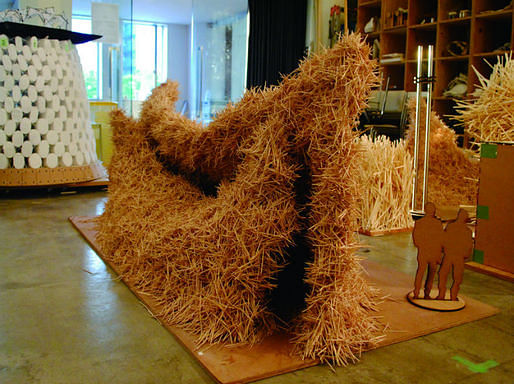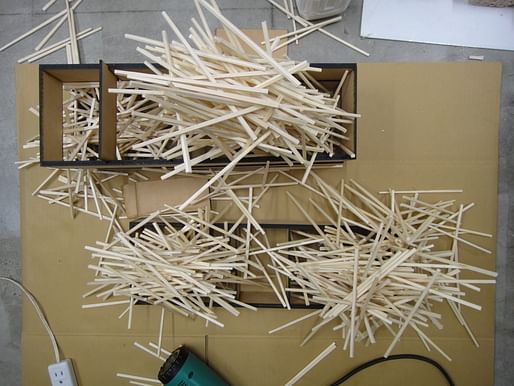
To kick-off this blog, I thought it would be good to describe the work we've been doing on our "STIK" project for the past eight months, the culmination of which was the construction of a large pavilion on the school grounds, as well as a food truck project in Omotesando, an area in southwest Tokyo.
The lab is setup so that every year, new master's students spend several months building the pavilion designed by the previous year students, in order to learn how to use digital tools and fabricate on an architectural scale. The next year is spent developing a new pavilion project, and the cycle repeats itself. Often, the concepts and research projects developed from previous years, as well as studies from other research institutions, are used as precedence studies from which we try to innovate.
This year, we looked at how the simple aggregation, or dropping of glue-coated sticks, could be controlled to build constructs.

In April, one of the research teams had experimented with the concept of aggregating stick-shaped elements. They had discovered that by pouring the components in lifts, they could pile them in such a way as to sculpt a target geometry. The lab, as well as our sponsor company for the year, Shimizu, and 2 other partners, Igarashi Lab and Sato Lab, thought this would be an interesting project to build at full-scale.
May was spend scaling up the toothpicks to chopsticks, and working on creating a basic machine so that we could be more consistent in how we aggregated the components. We also began building a program that could simulate how the sticks would aggregate, We found that Grasshopper / Python had a lot of difficulty handling the amount of discrete geometries required, and switched to processing so that we could handle more data.

Our first experiments with waribashi.

Early aggregation models using Processing's B-Rigid library.

Our very early machine, which went through many iterations over the next half+ year.
A student blog dedicated to ongoing happenings in and outside the Advanced Design Studies Program at the University of Tokyo.


2 Comments
Wow! Can you please talk more about the methodology? It looks like there is a lot of background that is compressed here. Very interesting project.
Hi Fred, of course! We're going to do a few more of these types of posts explaining how the rest of the project went, and then I'll post something about how we came to this point and what the general concept behind lab last year was, as well as were we might be heading this year.
Block this user
Are you sure you want to block this user and hide all related comments throughout the site?
Archinect
This is your first comment on Archinect. Your comment will be visible once approved.